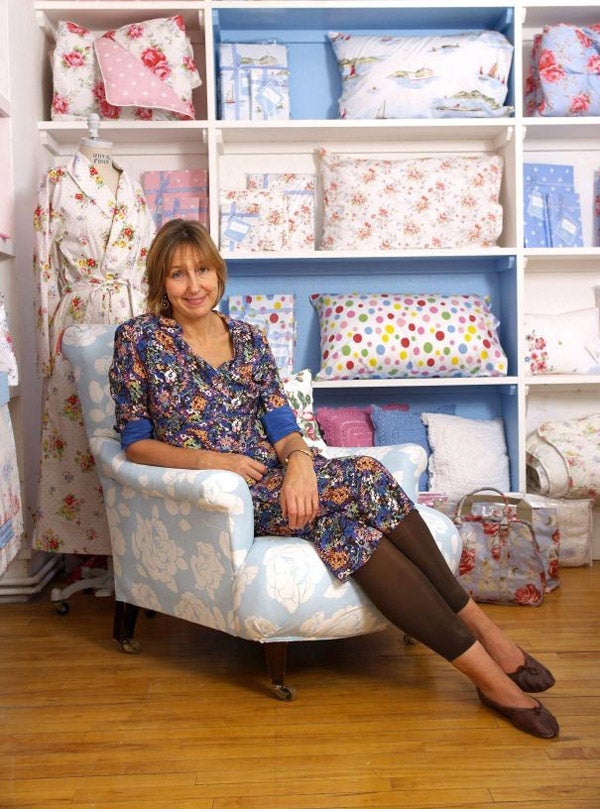Sitting pretty: The idea that sent Cath Kidson from one shop to a global chain

Today, Cath Kidston's iconic floral prints and affordable household items, that lend more than a nod to the trend for vintage chic, appear in must-have lists and households across the world. Her empire spans 28 shops and concessions in the UK, two shops in the Republic of Ireland and five in Japan. The brand has beaten the odds in the economic downturn with profits rising in the past year from £2.9m to £4.6m. And with sales now reaching £31.3m, she clearly has a head for retail. These figures belie the brand's humble beginnings in a small shop in London's Holland Park.
Kidston worked with interior designer Nicky Haslam before setting up a business in partnership with a friend, then branching out as a sole trader. She says she edged her way into having the confidence to strike out on her own but her previous experience stood her in good stead. "I worked as a shop assistant for about five years and I learnt a lot by being on the shop floor," Kidston says, recalling her childhood love of shops.
Kidston's first range sprang from the concept of old furniture painted white and old-fashioned fabrics that she "thought looked quite funky but affordable and [which] would be a suitable look for a family home". She says her stock was 95 per cent vintage, but she also invested in one wallpaper design and some gingham and rose-print fabric from eastern Europe. And her first product? An ironing board cover; something bright to cheer up her small flat. "I thought it would be the perfect product, because there I was, at home, doing my ironing on a grey ironing board. My flat was quite small and I had it hanging on the back of the door. I thought it was a really good idea."
It was. The Cath Kidston range continues to stock ironing board covers, but they are no longer made by Dot, the actress and seamstress who lived up the road from Kidston when she started up. "I'm not sure that they were fully flame-retardant in those days. I think health and safety might have something to say about it today, but the idea was there."
Ultimately, Kidston focuses on practicality while injecting some fun and frivolity into the everyday. "I love making pottery and china things, but I need to make something that's family friendly; I wouldn't make something that can't go in a dishwasher." Kidston's philosophy is about relaxed informal use rather than show. She says: "It helps to create some parameters around what we do."
Kidston says she didn't worry too much about brand creation when she started out. She concentrated on being original and says it's important to be doing something that no one else is doing. "It really doesn't interest me to run a company that's a cheaper version of another brand. There are all sorts of ways of approaching business, but it's good to try to create something individual." The clear style and look of her range comes from focusing on the print and the practical side.
The philosophy echoes that of a quintessentially British design hero, Laura Ashley, to whom Kidston has been recently compared. It's a comparison she is very flattered by, but which she finds slightly unrealistic. "When I was growing up, it was such a huge iconic brand. I think the similarities are that we are both homely companies using floral print but then they both have very different personalities if you delve down."
Kidston's role has changed over the 16 years since she started, but she's been lucky enough to be able to concentrate on the creative side. The excitement of the brand's beginnings came with a good dose of stress as well. "My poor husband! I'd go back home and talk to him about it and he would really cloud over. He didn't want to talk about a flowery wash-bag over supper – he was very tolerant," says Kidston.
She acknowledges that often the hardest part in starting up a new business is knowing where to turn to for advice. At the beginning her decisions were based on gut instinct. "The thing that has held me in good stead is knowing that I needed help in certain areas right from the word go," she says. At first it was a bookkeeper, because she didn't trust herself to "do it properly", but as the business grew she has relied on all sorts of talented people to keep the brand successful. She says: "It's really about trying to share other people's experience and allowing them to share in the growth equally. Recognising that you need that help is very important."
While she learnt her trade on the shop floor, she can see how university courses in retail could be a good place to start, provided they are combined with some practical experience. Kidston says: "Retail is about serving customers and understanding what it's like when someone walks into a shop. Whether you're doing online retail or whatever, it's an interaction with the customer. I would suggest plenty of work experience tied in with a degree could be a very good combination." She says the brilliance of retail is that it can be approached from so many different entry levels. Everyone has a chance to be as successful as she has been.
"It's such a great career, and it's one that's open to so many different people with different visions. Which is why I think it's so fantastic." If her enthusiasm and success are anything to go by, then a career in retail is a great choice.
Subscribe to Independent Premium to bookmark this article
Want to bookmark your favourite articles and stories to read or reference later? Start your Independent Premium subscription today.

Join our commenting forum
Join thought-provoking conversations, follow other Independent readers and see their replies